The Building Concept of the Goetheanum
GA 289
27 August 1921, Dornach
Translated by Steiner Online Library
7. About the Goetheanum
Dear attendees!
With your permission, I would like to expand on what I said during the tour of the Goetheanum by saying a few more words about our building today. For many years, our anthroposophical movement held its meetings in ordinary halls, just as they are available today. And even when we were able to present dramatic performances based on the impulses of the anthroposophical worldview, starting in 1909, we initially had to limit ourselves to having these performances in ordinary theaters and under ordinary theater conditions. As our anthroposophical movement grew, a large number of our friends came up with the idea of building a house for anthroposophy. And now I was given the task, so to speak, of creating a home for the anthroposophical movement. I would like to make it clear that the order to build did not come from me, but from friends of the anthroposophical worldview.
The question now arose: how should the construction of such a house be approached? If any other society, an association with any task or objective, builds a house for itself today – and today there are all kinds of associations with all kinds of objectives – then it consults with some architect. They agree on the style in which such a house is to be built: Greek, Gothic, Renaissance or some other style. This is the usual procedure today. If anthroposophy were a movement like all the others, it could have proceeded in this way. But anthroposophy takes into account the great demands of our time for a thorough renewal of our entire culture, and therefore it could not be built in this way.
Furthermore, anthroposophy is not a one-sided body of ideas, but the body of ideas of anthroposophy arises from the whole of human experience, from deep sources of the human being. And that which lives in the ideas of anthroposophy has sprung from a primeval source, just as it did in the case of the older cultures. And just as the words of Anthroposophy can be proclaimed by human mouths and given as teachings, so too can that which flows from the sources from which the Anthroposophical ideas also flow be given for direct artistic contemplation. It is not a matter of translating or applying anthroposophical ideas to art, but rather of another branch growing out of the same source of life from which anthroposophical ideas come, and developing as art. What Anthroposophy has to reveal can be said from a podium in words that signify ideas. But it can also speak from the forms, from plastic forms, from painting, without sculpture or painting becoming symbolism or allegory, but rather within the sphere of the purely artistic. But that means nothing other than: If anthroposophy creates a physical shell for itself in which it is to work, then it must give this physical shell its own style, just as older world views have given their physical shells the corresponding style.
Take the Greek architectural style, as it has partly been realized in the Greek temple: This Greek temple has grown entirely out of the same world view that gave rise to Greek drama, Greek epic poetry, and Greek conceptions of the gods. The Greek felt that in creating his temple, he was building a dwelling for the god. And the god is again nothing other than what older cultural views saw in the human soul that had passed through death in its further development; a certain qualitative relationship between the god and the human soul that has passed through death was felt in older cultural currents. And so, as in ancient times, when people believed that the human soul had passed through death, they built dwellings for it while still on earth, thus constructing houses for the dead, they designed something similar for the older times, as the Greeks then designed in their temples at a later stage. The temple is the dwelling of the god, that is, not of the human soul that has passed through death itself, but of that soul which belongs to a different hierarchy, to a different world order.
Those who can see forms artistically can still feel in the forms that have been created by carrying and other loads for the Greek temple, as in older times the dead, who still remained on earth after death, who, so to speak, as a chthonic deity, as an earthly deity, this house was formed out of this earth; so that a continuation of the gravitational forces of the earth, as they can be felt by man when he somehow looks through his limbs, such a connection of forces as a temple was erected. The Greek temple is only to be regarded as complete when one looks at it in such a way that the statue of the god is inside. Those with a sense of form cannot imagine an empty Greek temple as complete. They can only imagine, they can feel, that this shell contains the statue of Athena, Zeus, Apollo and so on.
Let's skip some of the art historical development and look at the Gothic building. If you feel the Gothic building with its forms, with its peculiar windows that let in the light in a unique way, you actually always feel that when you enter the empty Gothic cathedral, it is not a totality, nothing complete: the Gothic cathedral is only complete when the community is inside, whose souls resonate in harmony in their effects. A Greek temple is the wrapping of the god who dwells on earth through his statue in the people; a Gothic cathedral is in all its forms that which encloses the community in harmony and with thoughts directed towards the eternal.
Greek world view, world view that created form in the Gothic, are dead worlds for humanity. Only the degenerate forces of decline that originated from them can still live today. We need a new culture, but one that is not only expressed in a one-sided way in knowledge and ideas, but one that can also express itself in a new art. And so the development of art history also points to the necessity of a building style for anthroposophy, which wants to bring a new form of culture.
The way in which Anthroposophy is to be lived is based on the idea that a higher being, which is in fact the human being himself, speaks to the person who lives in the ordinary life that unfolds between birth and death. By feeling this, the two-dome structure presented itself to me as the necessary building envelope for this basic impulse of the anthroposophical world view. In the small dome, what is inwardly large and wide is, as it were, physically compressed; in the large dome, what is inwardly less wide, what inwardly belongs to the life we lead between birth and death, is spatially expanded.
And when a person enters this structure in the sense of such an anthroposophical worldview, they must find their own being. This is based on what has just been said. And while he is inside, he must feel the structure in such a way that he, as a human being, as a microcosm, does not feel constrained by the structure, but is externally connected to the universe, to the macrocosm, through the entire structure. But if you look at the structure from the outside, you must have the feeling: Something is going on in there that brings something unearthly, something extraterrestrial, to earthly existence. Something is going on in there that is hidden in the earthly itself. So it must be possible to look at the building in terms of its overall form and also in terms of the sculptural extensions, which, as I said over there, must represent organic structure.
I ask you to view the slides from this perspective, which I will now take the liberty of showing you. Of course, they show nothing other than what you have already seen; they are only intended to conclusively present what can be seen of the building. We will start by showing an exterior view looking towards the west portal.
The building seen from a little further away (Fig. 6), looking towards the west portal.

The next picture (Fig. 7): looking more towards the south portal, the west and south portals seen more together.
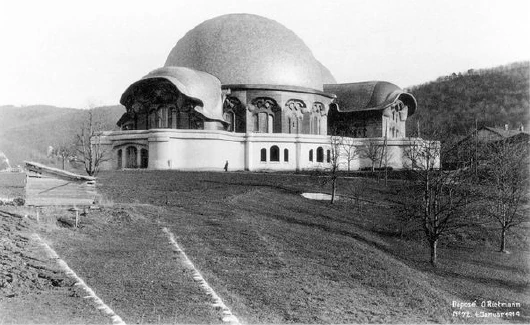
Here (Fig. 2) is a view of the building from the east, with a simultaneous view of the building that contains the lighting and heating units for the building. This boiler house is, of course, particularly controversial in its form because it looks different from the buildings we are accustomed to seeing today. And this boiler house is not built according to any principle other than everything that has been built here at all. The original idea was to have a number of heating and lighting systems. That is, in a sense, the nut. And now, as with the nut, only the nutshell can arise as a covering from an inner, logical necessity, and that, when one has such a utilitarian building, one cannot proceed otherwise than that one perceives everything that must be inside this structure in its essence and then makes a shell that corresponds to this content in the same way that the nutshell corresponds to the nut.

Of course, this can only be felt; it cannot be discussed. Another person may feel differently. But if one criticizes the ground, I would like to ask the people who do so to consider what would be there if no attempt had been made – even if it was not immediately successful at the first attempt – to find the right covering for heating and lighting, but had stuck with the current one, then there might be a red chimney here. Perhaps the philistines would have liked it more, but art would have been less satisfied.
The next picture (Fig. 4) will show a view from a greater distance of the north-west portal.
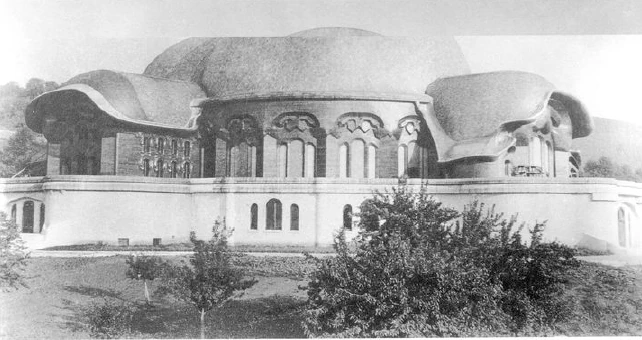
The next picture (Fig. 1) is supposed to show the building from an even greater distance.
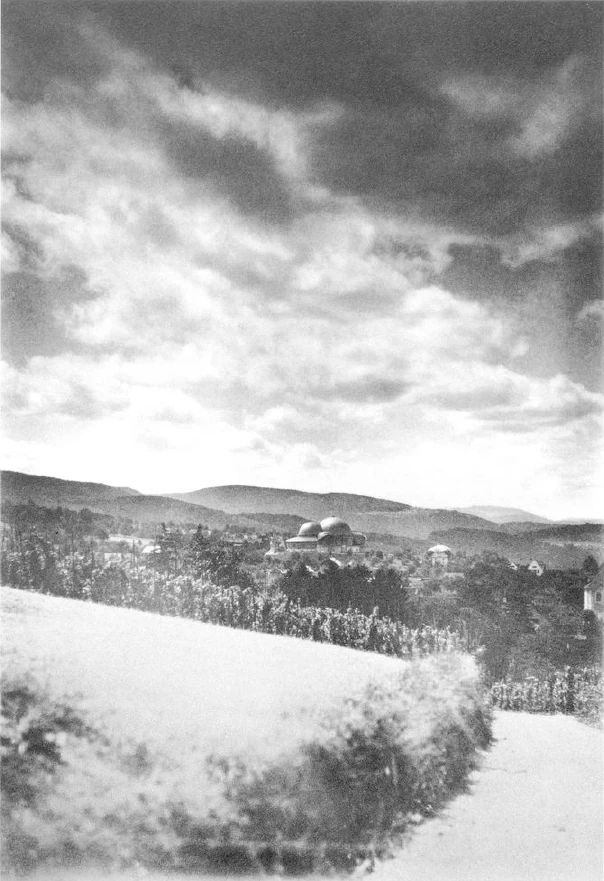
It was always my intention, despite the fact that the building was not originally intended for here, but in the middle of houses, to design it here so that it fits into the overall configuration of the landscape, the Jura landscape. I cannot, while trying to avoid any illusion, but say otherwise than that I think the building is already growing out of the plastic forms of the landscape.
Here I take the liberty of showing you the ground plan (Fig. 20), which expresses exactly what I have just said. The point was to feel through the effect, I would like to say, of one side of the human being on the other, in the ground plan and in the whole form of the building.
What now follows is a cross-section through the entire structure (Fig. 21).
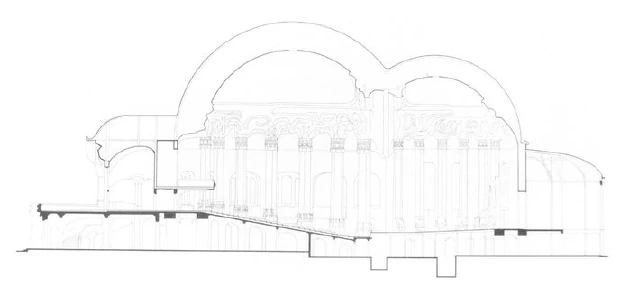
Now I will try to show this cross-section; I will try to show what can be built on this cross-section by showing you the model that I originally made (Fig. 22). This is the original model of the construction, the large dome, the small dome, as I made it here from the fall of 1913. It is largely made of wax, insofar as one is dealing with plastic forms, and partly of wood.
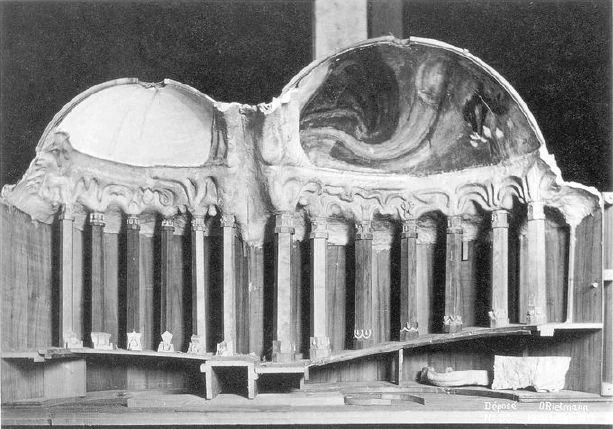
The next one will show a side wing, seen from the side (Fig. 13), where you can particularly see the metamorphosis that the motif, which can be seen above the west portal, can undergo in a smaller form. The forms become quite different on the outside, but according to the idea, they are the same on the inside.
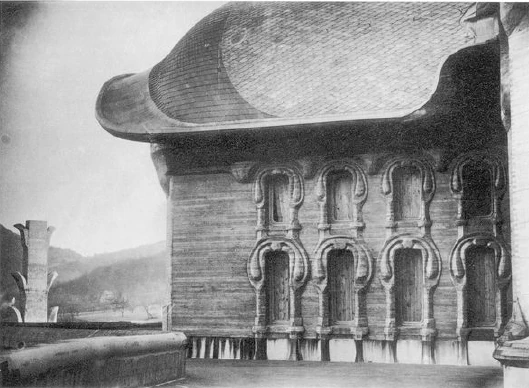
The next motif is depicted in the piece above the south portal, which is above the southern entrance door (Fig. 11): the same motif as on the west portal, but in a simpler, more primitive metamorphosis. Next, we present part of the room that one enters when going down into the concrete sub-room, which is intended for depositing the clothes (Fig. 23). One goes up there via the stairs. In any case, all the honored attendees have become aware of the underlying feelings behind the design of this room.
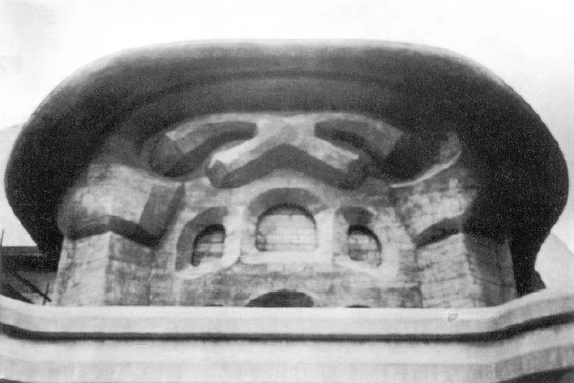
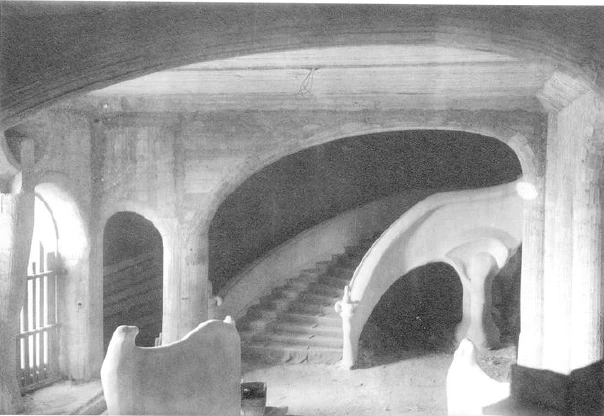
The staircase with its surroundings (Fig. 24), which we can pass over particularly quickly because they are only intended for recapitulation. The next thing I bring is a column from the interior, which one enters when one has gone up the stairs, that is, before one enters the main room (Fig. 27). Everything that is worked here is already worked in wood.
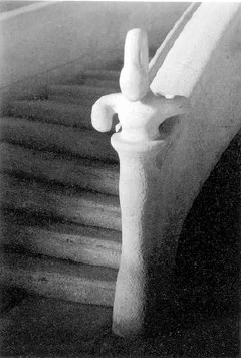
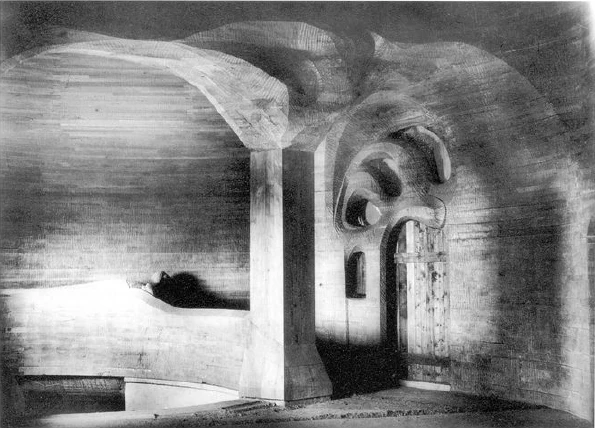
Here I present the organ motif, but not as you see it now, but as it was as a model (Fig. 30). It is a photograph of the organ motif model and you can see it here (Fig. 29) in an unfinished state at the same time. I said in the description over in the building that an attempt was made to design the whole sculpture around the organ so that the organ does not appear to be inserted into the space, but rather to have grown out of it. Here you can see the work of this organ sculpture still half-finished. First, I had to work out the general shape, and only later did I adapt the general forms to fit exactly with what emerged as the lines through the ends of the organ pipes upwards.
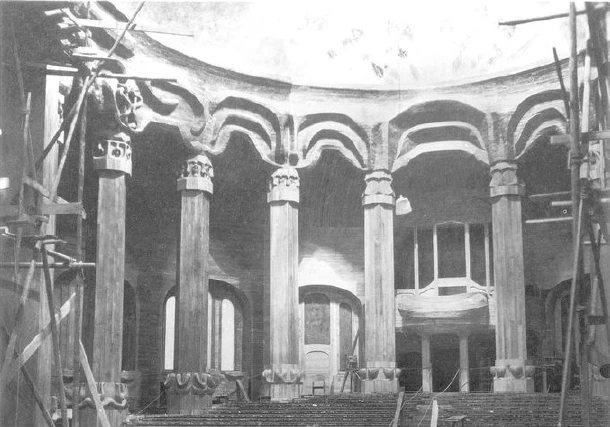
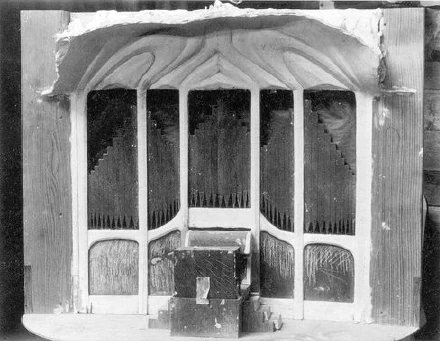
We now see in the next picture [the capital of the first column in the west] (Fig. 33), and I ask you to pay attention to the next three pictures. They are presented here to show two consecutive capitals. You should note that a single capital is actually not something that can be viewed on its own. The thing on which everything is based is the way in which each subsequent capital emerges from a preceding one. Therefore, I show two capitals emerging from each other [of the second and third columns] (Figs. 36, 38), and in between the two together [with the architrave above] (Fig. 37), thus each individual one in succession and in between the two together.
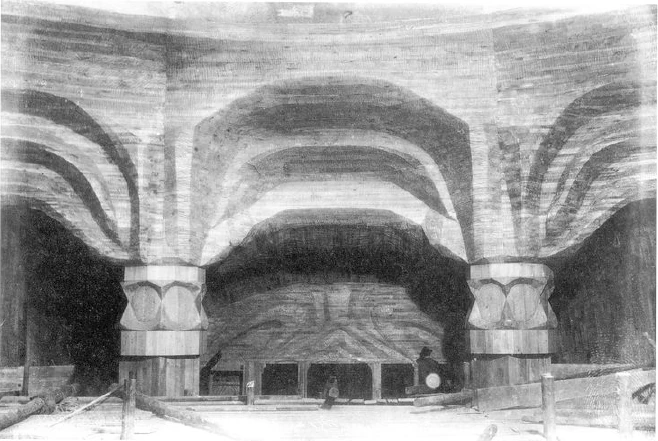
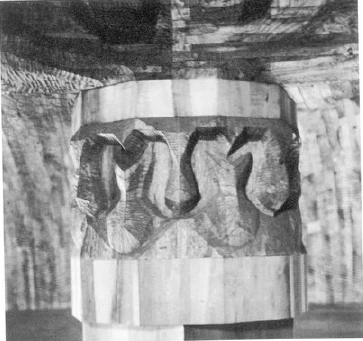
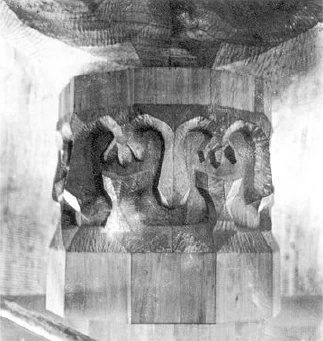
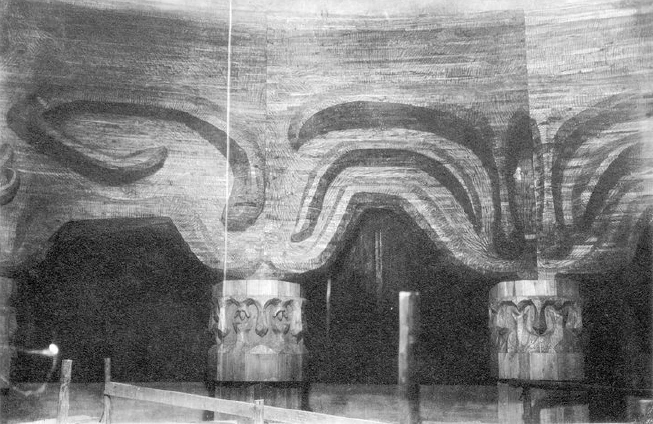
We see here the fourth capital (Fig. 40). Now the two capitals in succession, the fourth and fifth (Fig. 41). Now the fifth alone (Fig. 42).

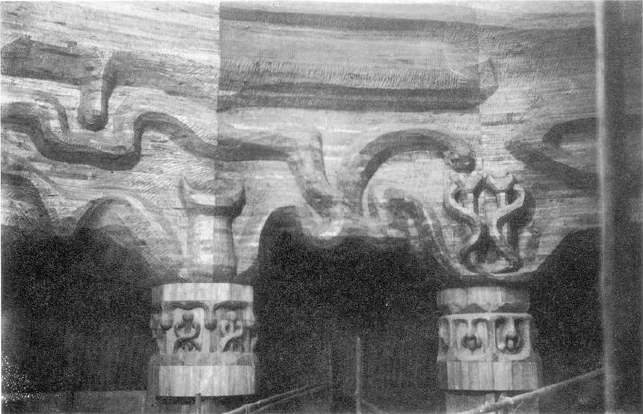
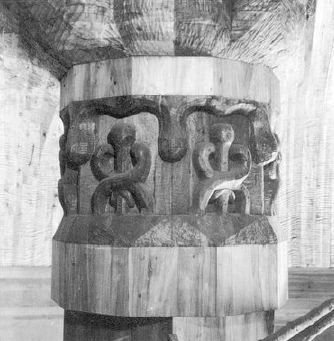
Likewise, I will now show two bases that have been formed one after the other, again the individual one is not to be understood in isolation, but only as emerging from what has gone before.
The first pedestal, the fifth (Fig. 52).
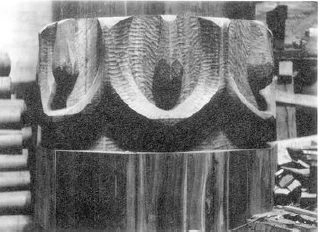
Now the sixth (Fig. 53). The next picture will show the motif that arises when we look east, standing in the building and see what is in the east (Fig. 57).

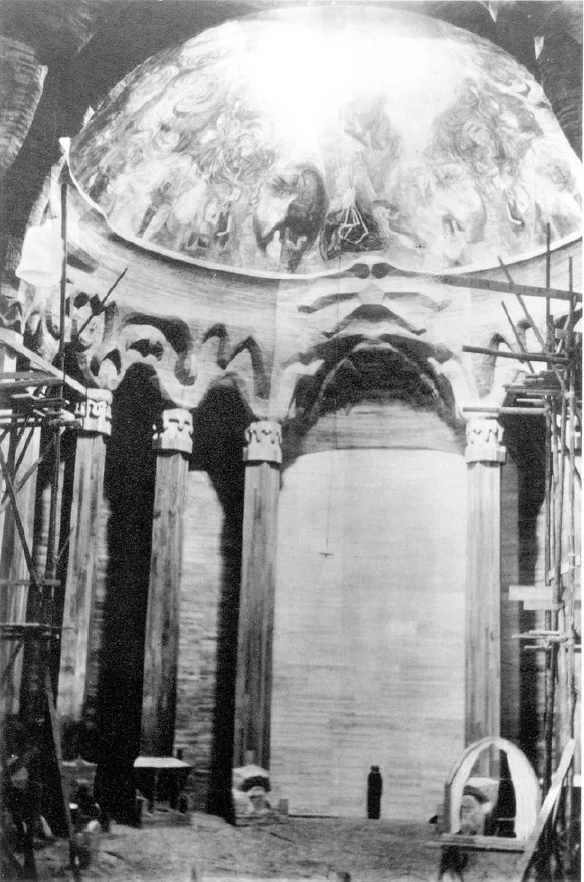
A column order: This is the view after the organ motif when standing in the building, looking from east to west (Fig. 29).

Here you can see the motif carved into the wood above the curtain slit (Fig. 55). The curtain is open, we look into the small domed room, and below we can also see the carving of the small domed room, only a little indistinctly, and above it the painting.
The next one shows the motif that was carved in the small domed room: as a kind of synthetic conclusion of the individual forms (Fig. 67). If you look from the auditorium into the small domed room, you will see, immediately below the painted Christ-like figure, with Lucifer above him and Ahriman below him, a wood carving that combines all the forms that are otherwise distributed throughout the building – but initially, I would like to say, only in an organic, not yet spiritualized way.
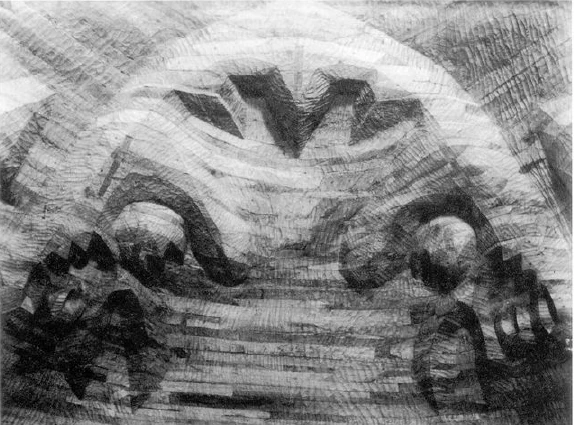
Psychically, it is only summarized in the Christ group (Fig. 93), which is a nine-meter-high wooden group that will stand in the far east and show the representative of humanity in the middle, who can be understood as the Christ – but must be understood in the feeling – [and] has the Luciferic principle above him and the Ahrimanic principle below him. Psychically, this will synthesize all the individual forms.
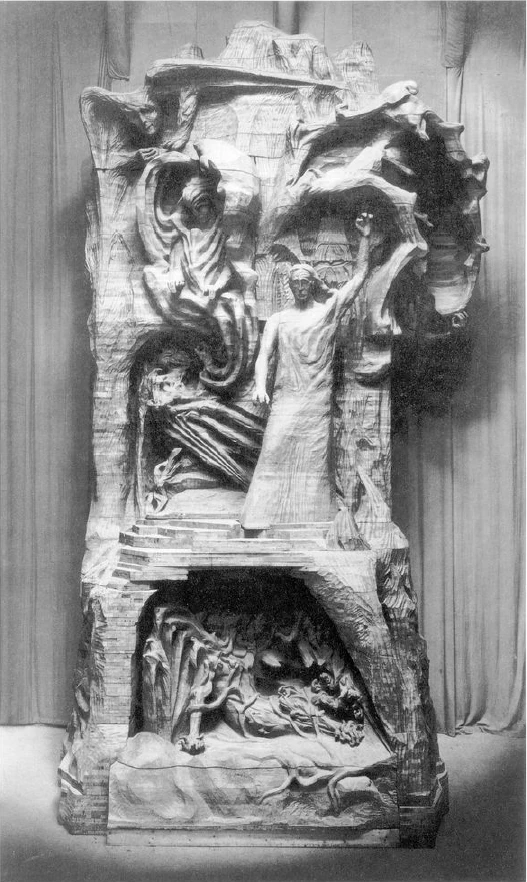
I will now describe some of the motifs in the small cupola painting.
First, you see the child, depicted in an orange tone (Fig. 72), in front of the blue figure, which looks like a fist (Fig. 70), holding a tablet with the “I” – the only word that will be found in the entire structure, for very specific reasons. I would be pleased, ladies and gentlemen, if you would feel something absurd from these pictures, which, after all, could only be viewed in black and white, because here the painting is done in such a way that everything is brought out in color. You can actually only give something in the reproduction in which, according to perception, something must be missing, something absurd. Perhaps one should see here that something quite unfinished, something absurd stands before one, and then one should give oneself the answer: it must actually be so, because the thing has meaning only in color. Whoever understands the inner meaning of the colored world will thoroughly grasp that even the figurative can, to a certain degree, be created entirely out of color. Those who see the blue above in the neighborhood of the other colors will perceive it purely as a possible creation from the color that a kind of Faust figure appears here. The next picture (Fig. 71) shows Death below Faust. The modern discerning person is placed between Death, the end of life, and Birth, the other end of life, which has been depicted in the child.

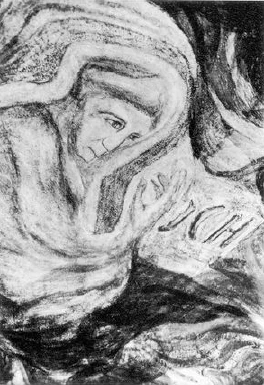
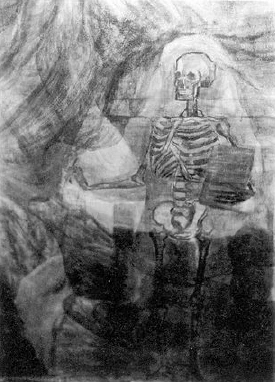
The next image (Fig. 78): a kind of figure that resembles an Egyptian initiate.
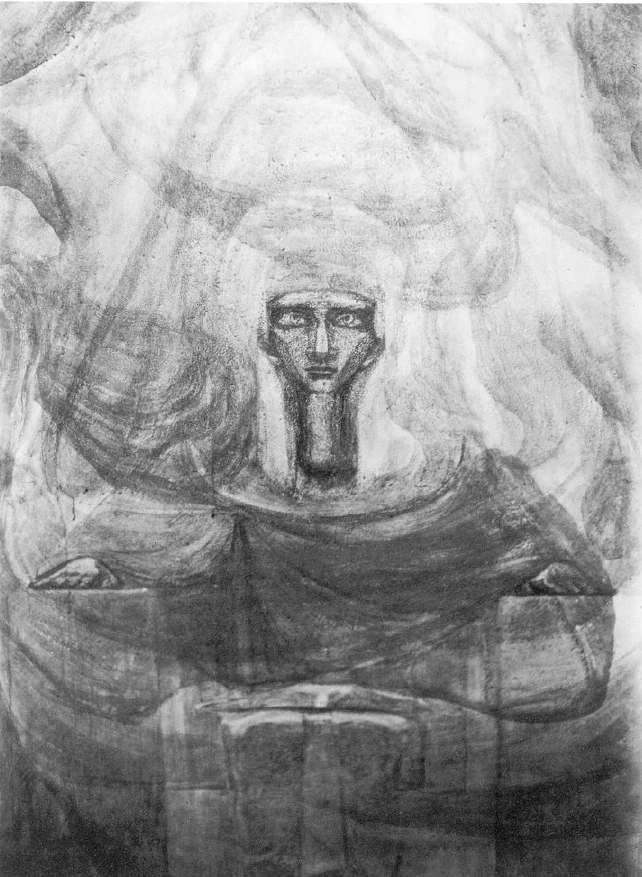
The inspirers hovering above him, initiating world powers (Fig. 77). From the way the treatment is presented, it will be clear that I may say: Although Figural is distinguished here from the colored, what I have said about the creative in color still applies.
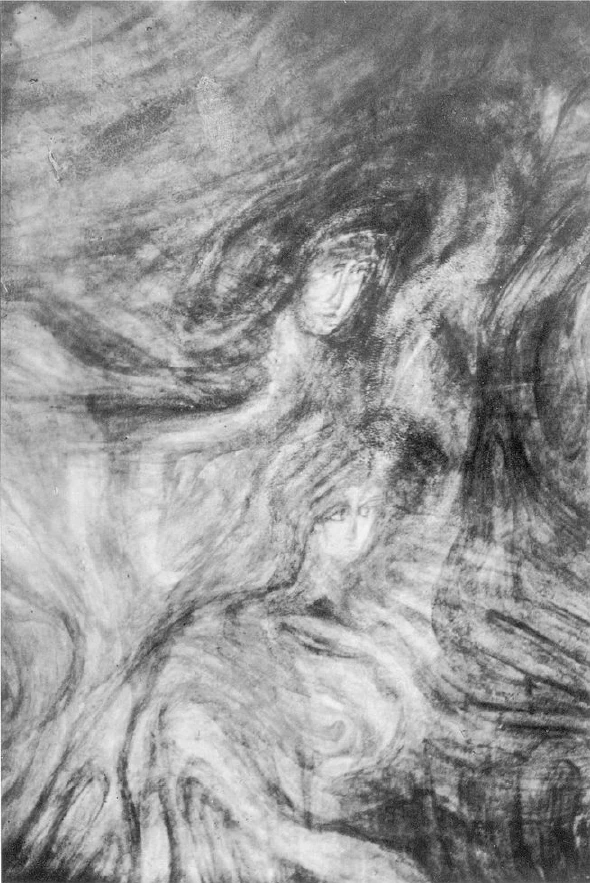
Here you can see a detail, a kind of ahriman head (Fig. 81). It is only conceivable to paint from the color used in the dome above: a peculiar brown-yellow.
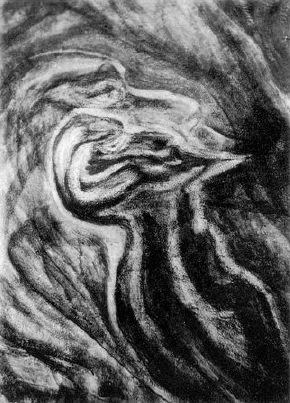
Here together: Ahriman head and Lucifer head (Fig. 79). They are only truly contrasted in color. The lower one shows what is inspired by Lucifer and Ahriman when they are grasped in their objectivity, when one is not grasped by them oneself, which is then particularly effective in man or can become so because man is of a special kind, who stands to the child as indicated in the lower figure.
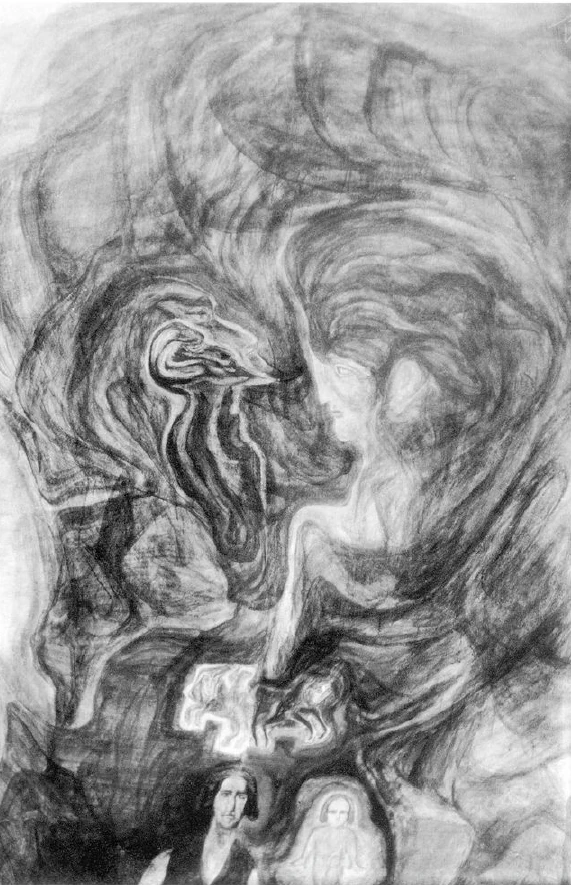
The next picture shows Lucifer's head on its own (Fig. 80), that is, painted; in sculpture, it looks different.
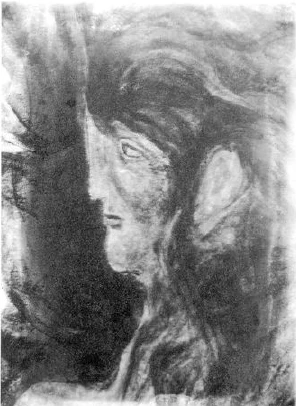
Here (Fig. 82) you see the [Germanic] man with the child, who has Ahriman and Lucifer above him, as shown earlier.
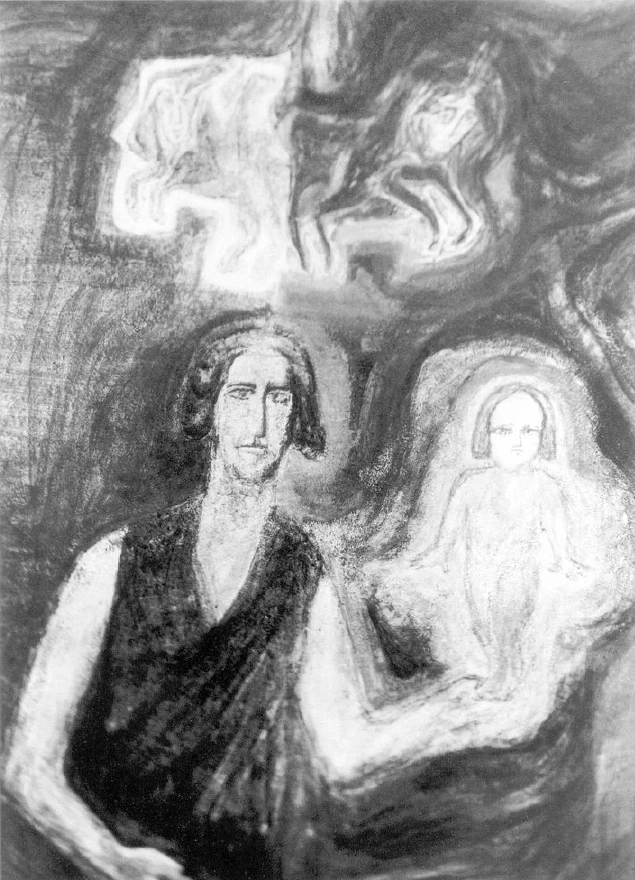
Here (Fig. 87) you can see Lucifer in a reddish-yellow painting above the representative of humanity in the central image of the small dome.
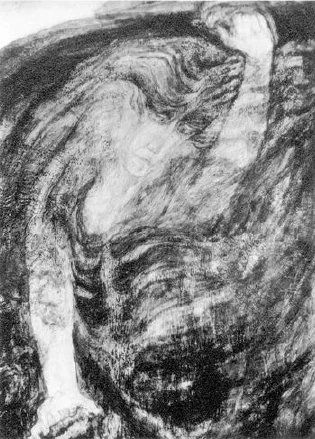
The next image (Fig. 88) then represents Ahriman under the representative of humanity – Ahriman, who is embraced with his love rays as if by a crushing lightning bolt.
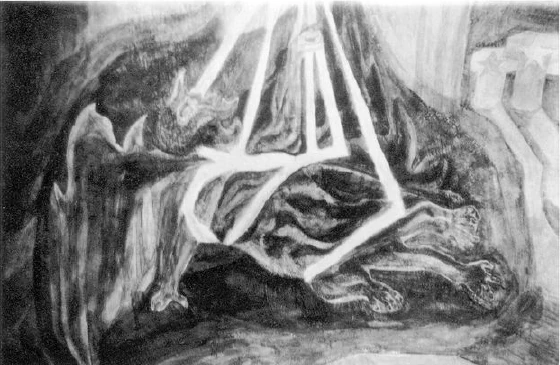
This is the painted Representative of Man, that is, the head of it (Fig. 90). This (Fig. 91) represents my model as it is initially worked in profile view of the Representative of Man; while what was shown earlier is a painting, this here is a sculpture. This is the first model of the Representative of Humanity in sculpture, the Representative of Humanity who can be felt as Christ.
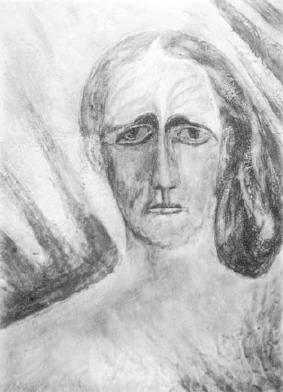
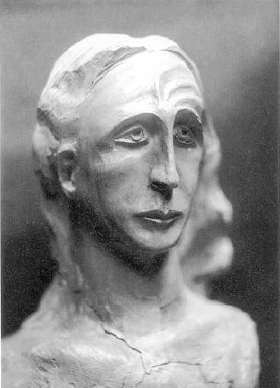
The next part will show the plastic group (Fig. 98). At the top left, this elemental being will show itself, an elemental being that has, to a certain extent, grown out of the forces of the rock. Below, you can see Lucifer striving upwards. The elemental being has grown out of the forces of the rock here in the wood group, whereby it becomes clear how one first dared here to work out ways of overcoming mere composition through organic design by means of asymmetry work out ways of overcoming mere composition through organic design, thus working in asymmetry. What is important here is that the form is worked out precisely from the place, with all its asymmetries, from the place where this being is located in the nine-meter-high group.
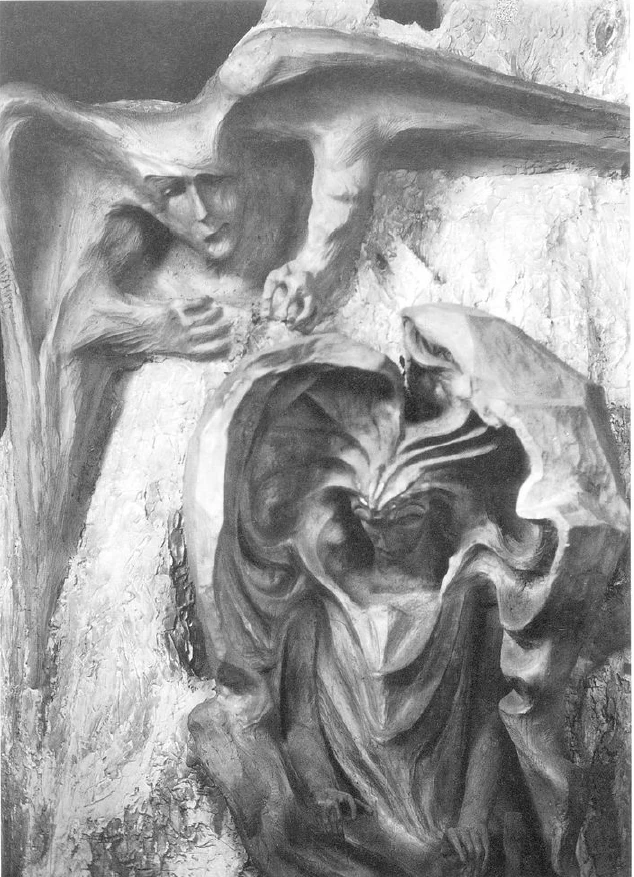
I will now show you my first Ahriman model (Fig. 99), which was created in 1915 in wax. The other Ahriman heads here are modeled after this Ahriman head. I would just like to note: This is what a person would look like if he had no heart at all and only reason. For the Ahrimanic represents the super-intellectual, the super-rational in man.
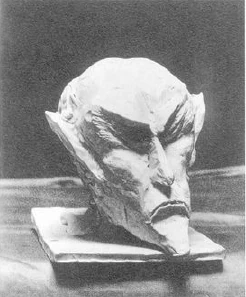
I will now show two views of the boiler house, the boiler and lighting house (Figs. 106, 107).
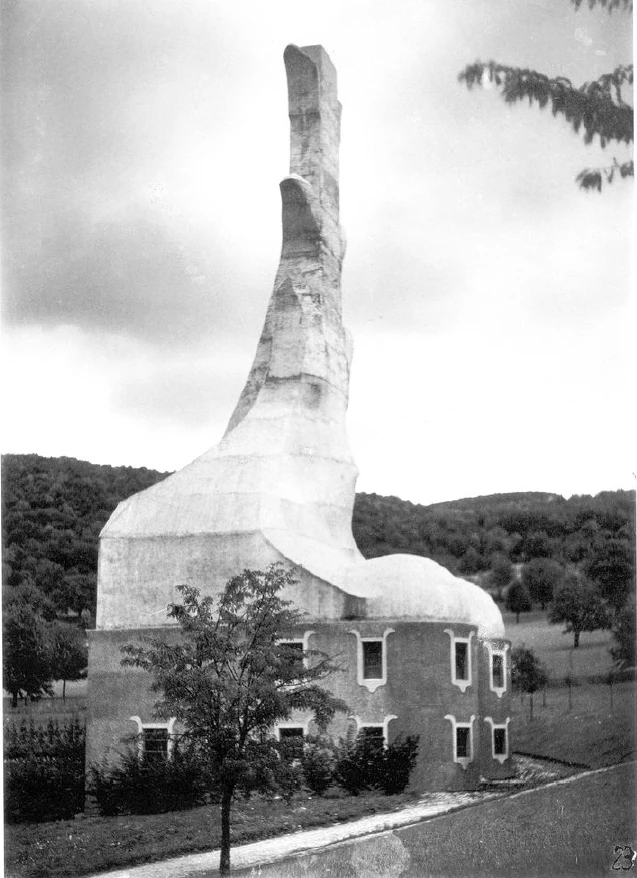
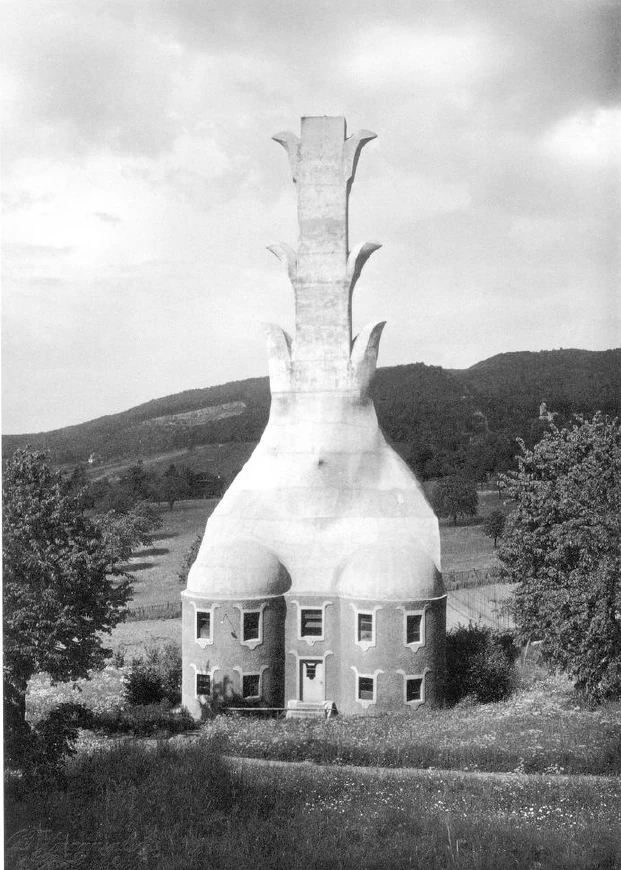
Now we come to the glass house below, in which you have held many a meeting here (Fig. 103). You can see the double-dome structure in a different form, a metamorphosis of the large building, metamorphosed in such a way that the two domes have to be the same size and do not adjoin each other, but are separate. I would like to illustrate the fact that everything about these buildings is individualized down to the last detail by showing you the gate of this glass house (Fig. 104), where you will see the individualization down to the stairs and the woodcarving.

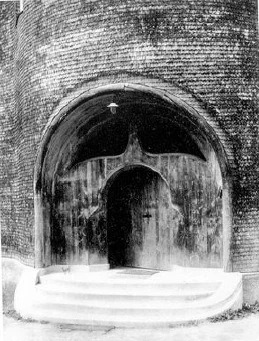
Now another picture (Fig. 110 or 112), which should show how what is intended by scratching out the colored glass pane, what is created from the feel of the material, so that it can only appear in the color in question. I ask you to look at this and see for yourself that if this appears uncolored, it is hideous.
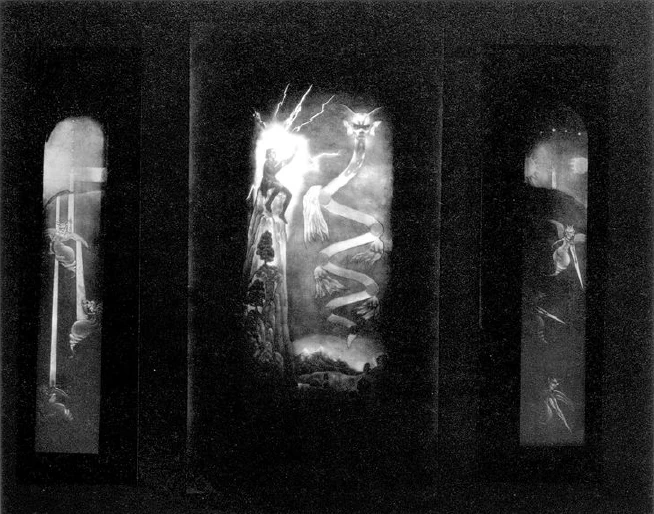
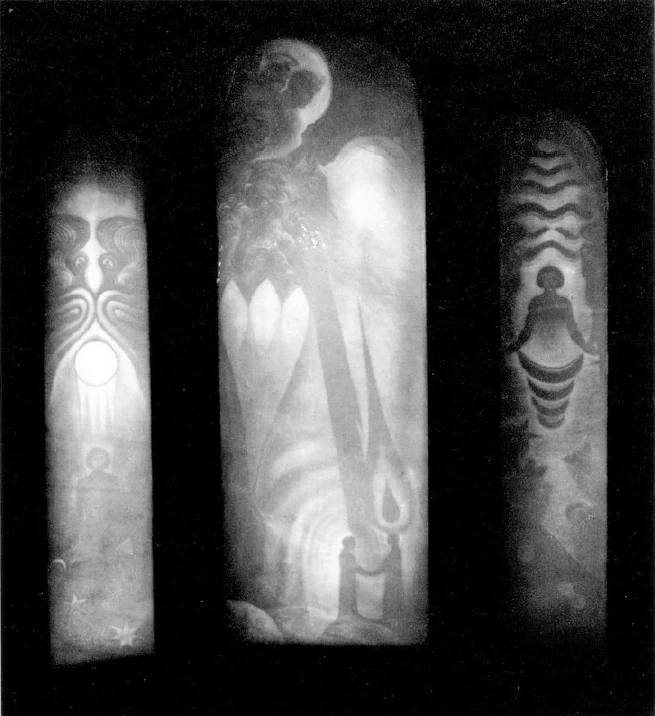
In recapitulating these things, I believe I have once again been able to point out how anthroposophy does not want to be just a science, but wants to be something that can act creatively in culture, that can speak in words, but that can also reveal itself in artistic forms. And now I just want to add at this point that perhaps it has emerged to you from what we have seen here in the building, what you have heard here in the building, what is intended and how it is connected with the signs of the times. The project that has come to fruition could only be realized through the great willingness of some of our members to make sacrifices; but the exchange rate situation in the world and the poverty of the Mediterranean countries have led us to a point where I I had to say, which was also spread by a small brochure that was sent to members: If we do not receive active help from the world, we will not be able to complete the building, but the building will have to come to a halt. If our members apply themselves with the same zeal to the completion of the building as they did to the founding of the World School Association, which is intimately connected with the building idea of Dornach, then we will soon be able to see a torso in the fall, which can be seen as a torso.
Since your time is limited, in particular the time of some of our esteemed visitors, I will not add anything further to what has been said, but ask you to come over to the building, where I will then take the liberty of saying a few closing words for this summer event.
7. Über Das Goetheanum
Meine sehr verehrten Anwesenden!
Sie werden gestatten, dass ich in Anknüpfung und Ergänzung zu dem, was ich mir erlaubt habe zu sagen bei der Führung durch das Goetheanum, hier einiges über unsern Bau noch zusammenfassend heute vorbringe. Unsere anthroposophische Bewegung hat viele Jahre hindurch so gewirkt, dass sie ihre Versammlungen in gewöhnlichen Sälen abhielt, wie man sie heute eben haben kann. Und auch als wir, vom Jahre 1909 angefangen, übergehen konnten dazu, Dramatisches darzustellen, das aus den Impulsen anthroposophischer Weltanschauung selbst genommen war, mussten wir uns zunächst darauf beschränken, diese Darstellungen in gewöhnlichen Theatern und unter den gewöhnlichen Theaterverhältnissen zu haben. Als nun unsere anthroposophische Bewegung größere Ausdehnung gewann, entstand bei einer großen Anzahl von Freunden die Idee, der Anthroposophie ein eigenes Haus zu bauen. Und nun wurde mir gewissermaßen - ich bemerke das ausdrücklich, weil der Auftrag zum Bauen nicht etwa von mir ausgegangen ist, sondern von Freunden der anthroposophischen Weltanschauung — der Auftrag gegeben, ein der anthroposophischen Bewegung entsprechendes Heim zu schaffen.
Es musste nun die Frage entstehen: Wie soll an den Bau eines solchen Hauses geschritten werden? Wenn irgendeine andere Gesellschaft, eine Vereinigung unter irgendeiner Aufgabe, einer Zielsetzung, heute sich ein Haus baut — was gibt es heute nicht alles Mögliche an Vereinigungen mit allen möglichen Zielsetzungen -, dann setzt sie sich auseinander mit irgendeinem Baukünstler. Man kommt überein, in welchem Stil, griechischem, gotischem oder Renaissancestil oder in einem sonstigen Baustil, solch ein Haus zu bauen. Das ist ja der gewöhnliche Vorgang von heute. Wäre Anthroposophie eine Bewegung, wie diese alle sind, dann hätte sie auch in dieser Weise vorgehen können. Aber Anthroposophie rechnet mit den großen Forderungen der Zeit nach einer durchgreifenden Erneuerung unserer ganzen Kultur, und deshalb konnte auf diesem Wege nicht gebaut werden.
Außerdem ist Anthroposophie nicht einseitig ein Ideengehalt, sondern der Ideengehalt der Anthroposophie entspringt aus dem ganzen menschlichen Erleben, aus tiefen Quellen des Menschenwesens heraus. Und dasjenige, was in den Ideen der Anthroposophie lebt, das ist geradeso, wie es bei den älteren Kulturen der Fall war, eben einer Urquelle entsprossen. Und es kann genauso, wie dasjenige, was Anthroposophie in Worten durch den Menschenmund zu verkündigen hat, genauso, wie das als Lehre gegeben werden kann, so kann auf der anderen Seite für die unmittelbare künstlerische Anschauung dasjenige gegeben werden, was aus den Quellen heraus fließt, aus denen auch die anthroposophischen Ideen fließen. Es ist nicht eine Übersetzung oder Umsetzung anthroposophischer Ideen in Kunst, um die es sich da handelt, sondern es ist ein anderer Zweig aus derselben Lebensquelle heraus, aus der die anthroposophischen Ideen kommen, der als Kunst sich entwickeln kann. Dasjenige, was Anthroposophie zu offenbaren hat, kann von einem Podium aus in Worten, die Ideen bedeuten, gesagt werden. Es kann aber auch aus den Formen, aus plastischen Formen, aus der Malerei heraus sprechen, ohne dass Plastik oder Malerei Symbolik oder Allegorie werden, sondern innerhalb der Sphäre des rein Künstlerischen stehen. Das heißt aber nichts anderes, als: Wenn Anthroposophie sich eine bauliche Umhüllung schafft, in der sie wirken soll, dann muss sie dieser baulichen Umhüllung ihren eigenen Stil geben, wie auch ältere Weltanschauungen ihren baulichen Umhüllungen den entsprechenden Stil gegeben haben.
Nehmen wir den griechischen Baustil, wie er sich zum Teil ausgelebt hat im griechischen Tempel: Dieser griechische Tempel ist ganz und gar aus derselben Weltanschauung herausgewachsen, aus der die griechische Dramatik, die griechische Epik, die griechischen Götteranschauungen herausgewachsen sind. Der Grieche hat gefühlt, dass er, indem er seinen Tempel schuf, dem Gotte ein Wohnhaus baute. Und der Gott ist wieder nichts anderes als dasjenige, was ältere Kulturanschauungen in der durch den Tod gegangenen Menschenseele in weiterer Entwicklung gesehen haben; eine gewisse qualitative Verwandtschaft zwischen dem Gotte und der Menschenseele, die durch den Tod gegangen ist, empfand man in älteren Kulturströmungen. Und so, wie man in alten Zeiten den durch den Tod gegangenen Menschenseelen, indem man sie noch auf der Erde glaubte, Wohnhäuser baute, indem man also Totenhäuser baute, gestaltete man für die älteren Zeiten etwas Ähnliches, wie die Griechen dann auf späterer Stufe in ihren Tempeln gestaltet haben. Der Tempel ist das Wohnhaus des Gottes, das heißt, nicht der selber durch den Tod gegangenen Menschenseele, sondern derjenigen Seele, die einer anderen Hierarchie, einer anderen Weltordnung angehört.
Wer Formen künstlerisch schauen kann, empfindet in den Formen, die durch Tragen und Lasten und anderes für den griechischen Tempel geschaffen worden sind, noch, wie in älteren Zeiten dem Toten, der sich nach dem Tode auf der Erde noch aufhielt, der gewissermaßen als chthonische Gottheit, als Erdengottheit wirkte, aus dieser Erde heraus dieses Wohnhaus geformt wurde; sodass eine Fortsetzung der Schwerkräfte der Erde, wie sie der Mensch empfinden kann, wenn er seine Gliedmaßenwesenheit irgend durchschaut, ein solcher Zusammenhang von Kräften als Tempel errichtet worden ist. Der griechische Tempel ist nur als vollständig anzusehen, wenn man ihn so ansieht, dass die Statue des Gottes drinnen ist. Derjenige, der Formgefühl hat, kann sich einen leeren griechischen Tempel nicht als etwas Vollständiges denken. Nur das kann er sich denken, das kann er empfinden, dass diese Hülle die Statue der Athena, des Zeus, des Apollon und so weiter in sich enthält.
Überspringen wir einiges in der kunstgeschichtlichen Entwicklung und sehen wir nach dem gotischen Bau hin. Der gotische Bau, wenn man ihn empfindet mit seinen Formen, mit seinen eigentümlichen Fenstern, die das Licht in einer eigentümlichen Weise einlassen, so empfindet man eigentlich immer, dass, wenn man in den leeren gotischen Dom hineingeht, er keine Totalität, nichts Vollständiges ist: Der gotische Dom ist erst vollständig, wenn die Gemeinde darinnen ist, deren Seelen in Harmonie in ihren Wirkungen zusammenklingen. Ein griechischer Tempel ist die Umhüllung des Gottes, der bei den Menschen auf Erden durch seine Statue weilt, ein gotischer Dom ist in all seinen Formen dasjenige, was die in Eintracht und mit den Gedanken nach dem Ewigen gerichtete Gemeinde in sich umschließt.
Griechische Weltanschauung, Weltanschauung, die sich in der Gotik Form geschaffen hat, sind für die Menschheit abgelebte Welten. Nur die aus ihnen stammenden degenerierten Niedergangskräfte können heute noch leben. Wir brauchen eine neue Kultur, aber eine Kultur, die sich nicht nur einseitig in Erkenntnissen und Ideen äußert, sondern eine Kultur, die sich auch in einer neuen Kunst äußern kann. Und so weist uns auch die kunstgeschichtliche Entwicklung auf die Notwendigkeit eines für die Anthroposophie, die eine neue Kulturform bringen will, notwendigen Baustiles hin.
Dasjenige, was Anthroposophie ausleben soll, beruht ja drauf, dass gewissermaßen eine höhere Wesenheit im Menschen, die aber der Mensch selbst ist, zu demjenigen Menschen redet, der im gewöhnlichen Leben lebt, das zwischen Geburt und Tod abläuft. Indem ich das durchempfand, ergab sich mir als die notwendige Bau-Umhüllung für diesen Grundimpuls anthroposophischer Weltanschauung der Zweikuppel-Bau. In der kleinen Kuppel, gewissermaßen äußerlich-physisch zusammengedrängt dasjenige, was innerlich groß und weit ist; in dem großen Kuppelraum dasjenige räumlich geweitet, was innerlich weniger weit ist, was innerlich dem Leben angehört, das wir eben zwischen Geburt und Tod führen.
Und wenn im Sinne einer solchen anthroposophischen Weltanschauung der Mensch diesen Bau betritt, so muss er seine eigene Wesenheit auffinden. Das ist in dem begründet, was eben gesagt worden ist. Und er muss, indem er drinnen ist, den Bau so empfinden, wie wenn er sich als Mensch, als Mikrokosmos nicht beengt fühlte durch den Bau, sondern durch die ganzen Bauformen mit dem Universum, mit dem Makrokosmos in einer äußerlichen Verbindung wäre. Wenn man aber den [Bau] von außen anschaut, so muss man das Gefühl haben: Da drinnen geht etwas vor, was zu dem irdischen Dasein ein Überirdisches, ein Außerirdisches dazubringt. Da drinnen geht etwas vor, was im Irdischen selber verborgen ist. So muss es möglich sein, den Bau anzuschauen nach seiner gesamten Form und auch nach den plastischen Ausweitungen, die, wie ich ja drüben gesagt habe, organische Gliederung darstellen müssen.
Von diesem Gesichtspunkte aus bitte ich die Lichtbilder anzusehen, die ich nunmehr mir erlauben werde Ihnen vorzuführen. Sie geben ja natürlich nichts anderes, als was Sie schon geschen haben; sie sollen nur abschließend vor die Seele bringen, was abschließend an dem Bau gesehen werden kann. Wir werden zunächst eine Ansicht von außen mit dem Blick nach dem Westportal hin zeigen.
Der Bau von etwas weiter angesehen (Abb. 6), Blick nach dem Westportal hin.

Das nächste Bild (Abb. 7): Ein Blick mehr nach dem Südportal hin, West- und Südportal mehr zusammen gesehen.

Hier (Abb. 2) ein Blick vom Osten auf den Bau hin mit der Aussicht zu gleicher Zeit auf dasjenige Gebäude, welches die Beleuchtungs- und Beheizungskörper für den Bau enthält. Dieses Kesselhaus ist in seiner Form natürlich ganz besonders angefochten, weil es ja anders ausschaut, als man bei Bauten gegenwärtig gewöhnt ist. Also auch dieses Kesselhaus ist nach keinem anderen Prinzip gebaut als alles, was hier überhaupt gebaut worden ist. Es handelte sich ursprünglich darum, eine Anzahl von Einrichtungen für die Beheizung, für die Beleuchtung zu haben. Das ist gewissermaßen die Nuss. Und nun handelt es sich darum, dass, wie bei der Nuss, aus einer inneren gesetzmäßigen Notwendigkeit nur die Nussschale als eine Umhüllung entstehen kann, dass auch, wenn man einen solchen Utilitätsbau hat, man nicht anders als so vorgehen kann, dass man alles dasjenige, was in diesem Bau drinnen sein muss, in seiner Wesenheit empfindet und dann eine Umhüllung macht, die in derselben Weise diesem Inhalt entspricht, wie die Nussschale der Nuss entspricht.

Natürlich lässt sich das nur empfinden; darüber lässt sich nicht diskutieren. Ein anderer mag es anders empfinden. Wenn man aber in den Grund und Boden kritisiert, so möchte ich den Leuten, die das tun, zu bedenken geben, was da stehen würde, wenn nicht versucht worden wäre - wenn es auch auf den ersten Anhub nicht gleich ganz gelungen ist -, für Heizung und Beleuchtung eine richtige Umhüllung zu suchen, sondern bei dem Heutigen stehengeblieben wäre, dann stünde hier vielleicht ein roter Schornstein. Vielleicht liebten Philister ihn mehr; aber die Kunst käme ja dabei weniger auf ihre Rechnung.
Das nächste Bild (Abb. 4) wird eine Ansicht geben mehr aus der Ferne auf das NordwestPortal.

Das nächste Bild (Abb. 1) soll von einer noch größeren Weite aus den Bau zeigen.

Es ist nun, trotzdem ja der Bau ursprünglich nicht für hier gedacht war, sondern mitten unter Häusern, doch mein Bestreben gewesen, ihn zuletzt hier so zu gestalten, dass er sich der ganzen Konfiguration der Landschaft, der Jura-Landschaft einfügt. Ich kann, indem ich versuche, mir jede Illusion zu nehmen, doch nicht anders als sagen, dass ich meine, der Bau wächst schon durchaus auch aus den plastischen Formen der Landschaft heraus.
Hier erlaube ich mir, Ihnen den Grundriss (Abb. 20) vorzuführen, der eben ausdrückt dasjenige, was ich vorhin ausgesprochen habe. Es handelte sich darum, eben das Wirken, ich möchte sagen, der einen Seite der menschlichen Wesenheit auf die andere, im Grundriss und in der ganzen Bauform durchzuempfinden.
Es folgt nun ein Durchschnitt durch den ganzen Bau (Abb. 21).

Nun werde ich diesen Durchschnitt noch so zu zeigen versuchen; Ich meine dasjenige, was auf diesem Durchschnitt aufgebaut werden kann, so zu zeigen versuchen, dass ich Ihnen hier zeige das Modell durchschnitten, das ich ursprünglich gemacht habe (Abb. 22). Dieses ist also das ursprüngliche Modell des Baues, des großen Kuppelraumes, des kleinen Kuppelraumes, wie ich es ausgefertigt habe hier ab Herbst 1913. Es ist zum großen Teil, insofern man es mit plastischen Formen zu tun hat, aus Wachs gemacht, zum andern Teil aus Holz.

Das nächste wird einen Seitentrakt bringen, von der Seite gesehen (Abb. 13), wo Sie besonders nun die Metamorphose betrachten können, welche das Motiv, das über dem Westportal zu sehen ist, bei kleinerer Form annehmen kann. Die Formen werden ja äußerlich-sinnlich ganz anders, sind der Idee nach aber doch innerlich anzuschauen dasselbe.

Das nächste Motiv stellt dar das Stück über dem Südportal, das über der südlichen Eingangstüre ist (Abb. 11): Dasselbe Motiv wie am Westportal, aber in einfacherer, primitiverer Metamorphose. Zunächst bringen wir jetzt einen Teil desjenigen Raumes, den man betritt, wenn man unten in den Beton-Unterraum hereingeht, der zum Ablegen der Kleider bestimmt ist (Abb. 23). Man geht dort über die Treppen hinauf. Es ist ja jedenfalls allen verehrten Anwesenden bekannt geworden, welche Empfindungen der Ausformung dieses Raumes zugrunde liegen.


Die Treppe mit dem, was dazugehört (Abb. 24), die wir besonders schnell übergehen können, weil sie ja nur zur Rekapitulation bestimmt sind. Das Nächste, was ich bringe, ist eine Säule aus dem Innenraum, den man betritt, wenn man über die Treppen hinaufgegangen ist, also bevor man in den Hauptraum hineingeht (Abb. 27). Es ist bereits alles dasjenige, was hier gearbeitet ist, in Holz gearbeitet.


Hier führe ich Ihnen das Orgelmotiv vor, aber nicht so, wie Sie es jetzt sehen, sondern wie es als Modell war (Abb. 30). Es ist fotografiert das Orgelmotiv-Modell und Sie sehen zu gleicher Zeit es hier (Abb. 29) im unfertigen Zustande. Ich habe ja gesagt bei der Beschreibung drüben im Bau, dass versucht worden ist, die ganze Plastik um die Orgel so zu gestalten, dass die Orgel nicht wie in den Raum hineingefügt erscheint, sondern aus ihm herausgewachsen. Sie sehen hier die Arbeit dieser Orgel-Plastik noch halbfertig. Man musste zunächst, ich möchte sagen, die Sache im Allgemeinen herausarbeiten, und erst später habe ich die allgemein herauszuarbeitenden Formen genau dem angepasst, was sich als die Linien ergeben hat durch die Enden der Orgelpfeifen nach oben.


Wir sehen jetzt in dem nächsten Bild [das Kapitell der ersten Säule im Westen] (Abb. 33), und ich bitte Sie, die drei nächsten Bilder zu beachten. Sie werden hier vorgeführt, um zwei aufeinanderfolgende Kapitelle zu zeigen. Sie sollen daraus entnehmen, dass ein einzelnes Kapitel anzusehen eigentlich nichts für sich ist. Dasjenige, worauf alles beruht, ist die Art, wie immer ein folgendes Kapitell aus einem vorhergehenden hervorgeht. Daher zeige ich zwei auseinander hervorgehende Kapitelle [der zweiten und dritten Säule] (Abb. 36, 38), und dazwischen die zwei zusammen [mit dem Architrav darüber] (Abb. 37), also jedes Einzelne aufeinanderfolgend und dazwischen die zwei zusammen.




Wir sehen hier das vierte Kapitell (Abb. 40). Nun die beiden Kapitelle aufeinanderfolgend, das vierte und fünfte (Abb. 41). Jetzt das fünfte allein (Abb. 42).



Ebenso werde ich jetzt zwei aufeinanderfolgend ausgebildete Sockel zeigen, wiederum der einzelne nicht für sich zu verstehen, sondern nur das Hervorgehen aus dem Vorhergehenden.
Der eine Sockel, der fünfte (Abb. 52).

Jetzt der sechste (Abb. 53). Das nächste Bild wird dasjenige Motiv zeigen, das sich ergibt, wenn wir einen Blick nach Osten werfen, im Bau stehend und sehen dasjenige, was als Motiv im Osten ist (Abb. 57).


Eine Säulenordnung: Das ist der Blick nach dem Orgelmotiv hin, wenn man im Bau steht, vom Osten nach dem Westen schauend (Abb. 29).

Hier sehen Sie dasjenige Motiv oben in Holz geschnitzt, welches sich über dem Vorhangschlitz befindet (Abb. 55). Der Vorhang ist offen, wir sehen in den kleinen Kuppelraum hinein, sehen unten auch die Schnitzerei des kleinen Kuppelraums, nur etwas undeutlich, und darüber die Malerei.
Das nächste gibt dasjenige Motiv, welches im kleinen Kuppelraum geschnitzt worden ist: gewissermaßen als der synthetische Abschluss der einzelnen Formen (Abb. 67). Wenn Sie vom Zuschauerraum in den kleinen Kuppelraum hineinsehen, so sehen Sie unmittelbar unter dem gemalten Christus-artigen Bild, das Luzifer über sich, Ahriman unter sich hat, in Holz geschnitzt alle Formen zusammengefasst, die sich sonst über den Bau verteilt finden - aber zunächst, ich möchte sagen, nur organisch, noch nicht seelenhaft zusammengefasst.

Psychisch nämlich ist es erst zusammengefasst in der Christusgruppe (Abb. 93), die eine neun Meter hohe Holzgruppe ist, ganz im Osten stehen wird und als Hauptfigur in der Mitte den Menschheitsrepräsentanten zeigen wird, der als der Christus aufgefasst werden kann - er muss es aber in der Empfindung - [und] über sich das luziferische, unter sich das ahrimanische Prinzip hat. Das wird psychisch alle einzelnen Formen zusammenfassen.

Ich gebe jetzt einige Motive aus der kleinen Kuppelmalerei.
Hier sehen Sie zunächst jenes Kind, das in einem Orangeton gehalten ist (Abb. 72), vor der blauen Figur, die Faust-ähnlich sich ausnimmt (Abb. 70), und die eine Tafel mit dem «Ich» — dem einzigen Wort, das sich als Ort in dem ganzen Bau finden wird, aus ganz bestimmten Gründen - hält. Es wäre mir angenehm, meine sehr verehrten Anwesenden, wenn Sie aus diesen Bildern, die ja nur in Schwarzweiß betrachtet werden konnten, etwas Absurdes empfinden würden, weil hier die Malerei so durchgeführt ist, dass alles aus der Farbe herausgeholt ist. Man kann eigentlich in der Nachbildung nur etwas geben, worin der Empfindung nach eben etwas fehlen muss, also etwas Absurdes. Man soll vielleicht hier gerade sehen, dass etwas ganz Unfertiges, etwas Absurdes vor einem steht, und man soll sich dann die Antwort geben: Das muss eigentlich so sein, weil die Sache einen Sinn nur in der Farbe hat. Wer den innerlichen Sinn der farbigen Welt versteht, der wird durchaus begreifen, dass selbst Figurales bis zu einem gewissen Grade durchaus aus der Farbe heraus geschaffen werden kann. Wer das Blau oben sieht in der Nachbarschaft der anderen Farben, wird es rein als aus der Farbe mögliche Schöpfung empfinden, dass hier eine Art Faust-Figur erscheint. Das nächste Bild (Abb. 71) zeigt den Tod unterhalb des Faust. Der modern erkennende Mensch, der hineingestellt ist zwischen Tod, dem Ende des Lebens, Geburt, dem anderen Ende des Lebens, das im Kinde zur Darstellung gekommen ist.



Das nächste Bild (Abb. 78): Eine Art Figur, die ähnlich ist einem ägyptischen Initiierten.

Die über ihm schwebenden Inspiratoren, initiierende Weltenmächte (Abb. 77). Durch die Art der Behandlung wird es ersichtlich sein, dass ich wohl sagen darf: Trotzdem sich Figurales hier aus dem Farbigen heraushebt, so gilt doch das, was ich über das in der Farbe Schöpferische gesagt habe.

Hier sehen Sie ein Detail, eine Art Ahrimankopf (Abb. 81). Es ist nur denkbar, aus der Farbe heraus zu malen, die oben in der Kuppel verwendet ist: ein eigentümliches Braun-Gelb.

Hier zusammen: Ahrimankopf und Luziferkopf (Abb. 79). Kontrastiert sind sie erst richtig in der Farbe. Unten dasjenige, [was inspiriert wird] von Luzifer und Ahriman, wenn man sie in ihrer Objektivität erfasst, wenn man nicht selber von ihnen erfasst wird, was dann im Menschen ganz besonders wirksam ist oder werden kann dadurch, dass der Mensch von besonderer Art ist, die so zum Kinde steht, wie es in der unteren Figur angedeutet ist.

Das nächste Bild stellt den Luziferkopf für sich dar (Abb. 80), also gemalt; plastisch nimmt er sich anders aus.

Hier (Abb. 82) sehen Sie den [germanischen] Menschen mit dem Kind, der über sich Ahriman und Luzifer hat, wie es vorhin gezeigt worden ist.

Hier (Abb. 87) sehen Sie den Luzifer in einer rötlich-gelben Malerei über dem Menschheitsrepräsentanten im Mittelbilde der kleinen Kuppel.

Das nächste Bild (Abb. 88) stellt dann Ahriman dar unter dem Menschheitsrepräsentanten — Ahriman, der umschlungen wird mit seinem Liebestrahlen wie von einem zermalmenden Blitz.

Das ist der gemalte Menschheitsrepräsentant, das heißt der Kopf davon (Abb. 90). Dieses (Abb. 91) stellt mein Modell dar, wie es zunächst gearbeitet wird in Profilansicht vom Menschheitsrepräsentanten; während das früher Gezeigte also eine Malerei darstellt, stellt dieses hier eine Plastik dar. Das ist das erste Modell des Menschheitsrepräsentanten in der Plastik, des Menschheitsrepräsentanten, den man als Christus empfinden kann.


Das nächste wird darstellen einen Teil der plastischen Gruppe (Abb. 98). Links oben wird sich dieses Elementarwesen zeigen, ein Elementarwesen, gewissermaßen aus den Kräften des Felsens herausgewachsen. Unterhalb sehen Sie den hinaufstrebenden Luzifer. Das Elementarwesen [ist] aus den Kräften des Felsens herausgewachsen hier in der Holzgruppe, wobei ersichtlich wird, wie man hier zuerst gewagt hat, mit Asymmetrie Wege der Überwindung der bloßen Komposition durch das organische Gestalten zu [er]arbeiten, also in Asymmetrie zu arbeiten, Es kommt hier darauf an, dass die Form genau aus dem Orte heraus gearbeitet ist mit allen [Asymmetrien], aus dem Orte, an dem sich dieses Wesen in der neun Meter hohen Gruppe befindet.

Ich zeige Ihnen jetzt mein erstes Ahrimanmodell (Abb. 99), welches 1915 entstanden ist, in Wachs gearbeitet. Nach diesem Ahrimankopf sind die anderen Ahrimanköpfe hier gearbeitet. Ich bemerke nur: So würde der Mensch aussehen, wenn er gar kein Herz und nur Verstand hätte. Denn das Ahrimanische stellt das Übergescheite, das Überverstandesmäßige im Menschen dar.

Ich zeige jetzt zwei Ansichten vom Heizhaus, dem Kessel- und Beleuchtungshaus (Abb. 106, 107).


Nun kommt auch das untenstehende Glashaus, in welchem Sie so manche Versammlungen hier abgehalten haben, zur Darstellung (Abb. 103). Sie sehen da den Doppelkuppel-Bau in einer anderen Form, eine Metamorphose des großen Baues, metamorphosiert gerade in der Weise, dass eben die beiden Kuppeln gleich groß sein mussten und nicht aneinandergrenzen, sondern auseinander liegen. Dass hier an diesen Bauten alles bis ins Einzelne hinein individualisiert ist, möchte ich noch veranschaulichen durch das Tor dieses Glashauses (Abb. 104), an dem Sie die Individualisierung bis zu der Treppe hinunter und bis zu der Holzschnitzerei sehen werden.


Jetzt noch ein Bild (Abb. 110 oder 112), welches zeigen soll, wie dasjenige, was durch das Auskratzen in der farbigen Glasscheibe gedacht ist, was aus dem Materialgefühl heraus so geschaffen ist, dass es eben nur in der betreffenden Farbe erscheinen kann. Ich bitte Sie, das hier anzusehen und sich zu überzeugen, dass wenn das unfarbig erscheint, es scheußlich ist,


Indem ich diese Dinge rekapitulierte, glaubte ich noch einmal hinweisen zu können darauf, wie Anthroposophie nicht sein will nur eine Wissenschaft, sondern sein will durchaus dasjenige, was kulturschaffend auftreten kann, was in Worten sprechen kann, was aber auch in künstlerischen Formen sich offenbaren kann. Und nun will ich nur noch hinzufügen an dieser Stelle, dass Ihnen ja vielleicht hervorgegangen sein kann aus demjenigen, was wir hier im Bau gesehen haben, was Sie hier am Bau gehört haben, was gewollt ist und wie es zusammenhängt mit den Zeichen der Zeit. Es konnte dasjenige, das zustande gekommen ist, nur [zustande kommen] durch die große Opferwilligkeit eines Teiles unserer Mitglieder; aber wir sind durch die Valuta-Verhältnisse der Welt, durch die Armut der Mittelländer auf einem Standpunkt angekommen, von dem aus ich dasjenige sagen musste vor kurzer Zeit, was ja auch durch eine kleine Broschüre verbreitet worden ist, die bei den Mitgliedern herumgeschickt worden ist: Wenn wir nicht tatkräftige Hilfe von der Welt erhalten, so werden wir den Bau nicht zu Ende führen können, sondern es wird der Bau stillstehen müssen. Wenn der Eifer unserer Mitgliedschaft sich dieser Bau-Vollendung in derselben Weise zuwendet, wie man sich zugewendet hat der Begründung des Welt-Schulvereins, die innig mit dem Baugedanken von Dornach zusammenhängt, so werden wir im Herbste sehr bald vor einem Torso stehen, den man wird als Torso ansehen können.
Ich darf, da Ihre Zeit bemessen ist, namentlich die Zeit eines Teiles unserer verehrten Besucher, zu dem Gesagten jetzt nichts weiter hinzufügen, sondern bitte Sie, hinüberzukommen in den Bau, wo ich mir dann gestatten werde, noch ein paar Schlussworte für diese Sommerveranstaltung zu sprechen.

